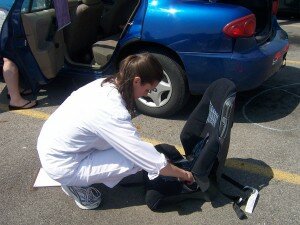 Safe Kids Central Ohio works closely with parents, caregivers, and community agencies to keep kids safe when traveling in motor vehicles. Our comprehensive child passenger safety program strives to educate every driver who transports children about the importance of buckling up and using their child safety seats correctly.
Safe Kids Central Ohio works closely with parents, caregivers, and community agencies to keep kids safe when traveling in motor vehicles. Our comprehensive child passenger safety program strives to educate every driver who transports children about the importance of buckling up and using their child safety seats correctly.
Child Safety Seat Distribution Program
Riding unrestrained is the single greatest risk factor for death and injury among children traveling in a motor vehicle. In an effort to reduce the number of children riding unrestrained, Safe Kids Central Ohio and Columbus Public Health have teamed up to offer child safety seat classes.
Our child safety seat distribution program is designed to provide child safety seats at a reduced cost to families in need. We distribute seats for $30 a child ($10 for a booster seat) to parents meeting income guidelines. Parents are required to attend a one-hour educational class where they will learn how to use and install their child safety seat correctly. Classes are also open to parents who would like to learn about common misuses and ensure they are using their child’s safety seat correctly.
The classes are held several times a month at Columbus Public Health. For more information or to sign up, call (614) 645-7748.
Child Safety Seat Check Up Events
A child safety seat may not protect a child in a crash, if it is not properly installed and used correctly. According to National Safe Kids, an estimated 85% of children who are placed in child safety seats and booster seats are improperly restrained.
Since 2008, over 2,100 child safety seats were checked in Central Ohio. Data shows that 92% of these child safety seats were not being used correctly.
Common misuse issues include, but are not limited to:
- Using an inappropriate seat for a child’s age and size.
- Placing an infant forward facing before they reach 1 year of age and 20 pounds.
- Not securing the child safety seat tightly in the vehicle.
- Not tightening the harness straps or adjusting the chest clip to armpit level.
In a continuing effort to decrease misuse, our mobile child safety seat check up van travels to various locations throughout Central Ohio to conduct regularly scheduled child safety seat checks.
At these events, certified child passenger safety technicians will work one on one to ensure that all aspects of safety relative to the child, the car seat and the vehicle are explored.
For more information, questions about carseats, or to find a child safety seat check up event near you, call (614) 645-7748 or check out our events page.
Four Stages of Restraint
The following four stages for kids help keep them safe in the car:
1) Rear-Facing: Children should begin life riding rear-facing, and continue riding that way until at least the second birthday. Once they have outgrown their infant carrier into a rear-facing convertible seat. For best protection, they should ride rear-facing until they have outgrown their convertible seat in the rear-facing position, even past the second birthday if possible. At this time, children should turn forward-facing.
2) Forward-Facing: Children who are at least two, and who have outgrown their rear-facing child restraint, may sit forward-facing in the car in a seat with an internal harness. They should remain in this internal harness until they are at least four years and forty pounds, or better yet, until they have outgrown the harness (by either weight or height,) when they should move to a booster seat.
3) Booster Seat: Boosters are for big kids, to fill the gap between outgrowing their child safety seat and fitting the adult seat belt properly. Kids should graduate to booster seats after outgrowing their forward-facing harnessed seat, and remain it it until they can pass the 5-Step Test, generally somewhere between 10 & 12, indicating proper seat belt fit.
4) Adult Seat Belt: Once kids fit properly into the adult seat belt, they should use it for the rest of their life: every ride, every time.
For a printable handout of these guidelines, check out NHTSA’s excellent Car Seat Recommendations For Children flyer.




